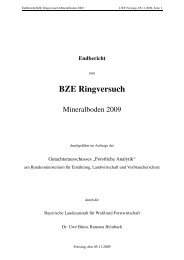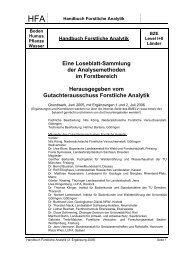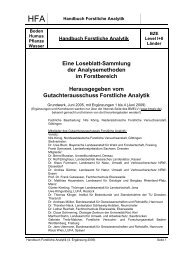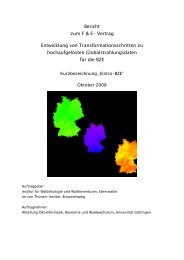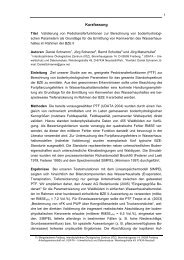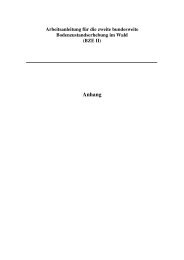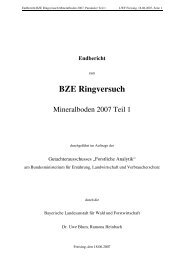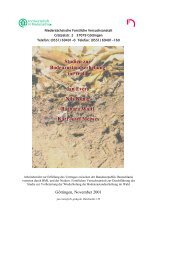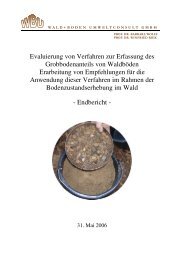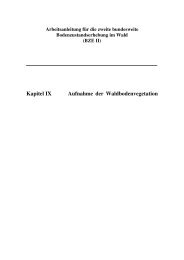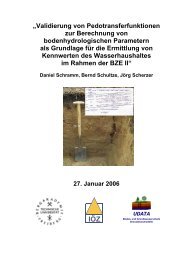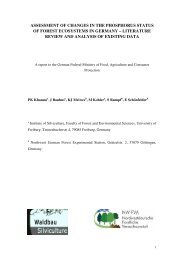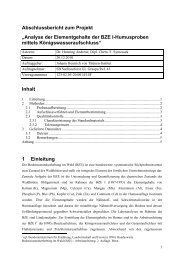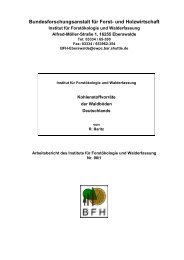assessment of changes in the phosphorus status of forest ...
assessment of changes in the phosphorus status of forest ...
assessment of changes in the phosphorus status of forest ...
Create successful ePaper yourself
Turn your PDF publications into a flip-book with our unique Google optimized e-Paper software.
3.3 Use <strong>of</strong> pedo-transfer functions to assess availability and <strong>the</strong> amount <strong>of</strong><br />
available soil P<br />
Pedo-transfer functions (PTF) are predictive functions for soil properties, which are<br />
not easy to measure but can be derived from o<strong>the</strong>r more-available, easily, rout<strong>in</strong>ely or<br />
cheaply measured soil parameters. McBratney et al. (2002) used <strong>the</strong> term ‘soil<br />
<strong>in</strong>ference system’, where pedo-transfer functions are <strong>the</strong> knowledge rules for soil<br />
<strong>in</strong>ference eng<strong>in</strong>es. A soil <strong>in</strong>ference system takes measurements with a given level <strong>of</strong><br />
certa<strong>in</strong>ty (source) and by means <strong>of</strong> logically l<strong>in</strong>ked pedo-transfer functions (organiser)<br />
<strong>in</strong>fers unknown data with m<strong>in</strong>imal <strong>in</strong>accuracy (predictor). Pedo-transfer functions<br />
thus utilize different regression analysis and data m<strong>in</strong><strong>in</strong>g techniques to extract rules<br />
for soil properties which are difficult to measure.<br />
For this review we <strong>in</strong>tend to consider <strong>the</strong> possibility <strong>of</strong> us<strong>in</strong>g pedo-transfer functions<br />
to assess <strong>the</strong> amount <strong>of</strong> different P forms <strong>in</strong> <strong>forest</strong> soils, which would enable <strong>the</strong><br />
evaluation <strong>of</strong> long term soil P <strong>changes</strong> <strong>in</strong> <strong>forest</strong> ecosystems. Earlier attempts have led<br />
to regression relationships which were based on 12 different sites collected <strong>in</strong> Lower<br />
Saxony (Ulrich and Khanna 1972, Khanna and Ulrich 1969, Ulrich 1972). The basis<br />
<strong>of</strong> <strong>the</strong>se relationships are described below <strong>in</strong> short:<br />
• Total P (Pt) is considered to be a function <strong>of</strong> organic C <strong>in</strong> <strong>the</strong> surface soils which<br />
can be described by <strong>the</strong> equation Pt = a+b (%C). Here <strong>the</strong> assumption is that Pt<br />
follows <strong>the</strong> depth-wise distribution parallel to that <strong>of</strong> C and <strong>the</strong> parameter ‘a’<br />
describes that fraction <strong>of</strong> P <strong>in</strong> soil, which does not undergo any biologically driven<br />
P transformation and translocations. The value <strong>of</strong> ‘a’ is thus based on <strong>the</strong> type <strong>of</strong><br />
bedrock material, which was found to be 5 mg P /100g for silicate-poor diluvial<br />
sand (site - Meppen), 10 mg P/g for <strong>the</strong> diluvial sand which had medium amounts<br />
<strong>of</strong> silicates (site - Sprakensehl), 32 mg P/g for <strong>the</strong> soil from loess on sandstone<br />
(site – Soll<strong>in</strong>g). The value <strong>of</strong> ‘b’ <strong>in</strong> <strong>the</strong> equation can range from 2 to 7 depend<strong>in</strong>g<br />
upon <strong>the</strong> soil type and root<strong>in</strong>g depth. The significance <strong>of</strong> assess<strong>in</strong>g <strong>the</strong> distribution<br />
<strong>of</strong> total P <strong>in</strong> soil <strong>in</strong> relation to organic matter content is <strong>in</strong>dicated by <strong>the</strong> role <strong>of</strong><br />
biological parameters <strong>in</strong> <strong>the</strong> transformation and translocation <strong>of</strong> P <strong>in</strong> a soil pr<strong>of</strong>ile.<br />
• Now assum<strong>in</strong>g that occluded P fractions (Poccl) (which also <strong>in</strong>cludes secondary or<br />
primary silicates) are not taken up by <strong>the</strong> roots and are not <strong>in</strong>volved <strong>in</strong> <strong>the</strong><br />
retranslocation processes, one can def<strong>in</strong>e <strong>the</strong> fraction <strong>of</strong> occluded P as : Poccl / Pt x<br />
100 = a+b log(%C). The values <strong>of</strong> parameter ‘a’ may vary from 30-45% and that<br />
<strong>of</strong> parameter ‘b’ which has negative values <strong>of</strong> 18 – 31. Ulrich (1972) suggested<br />
67



